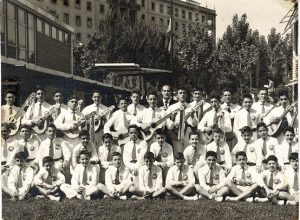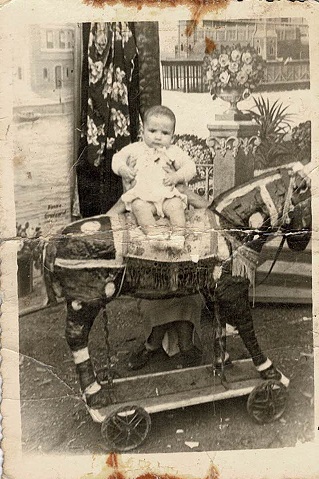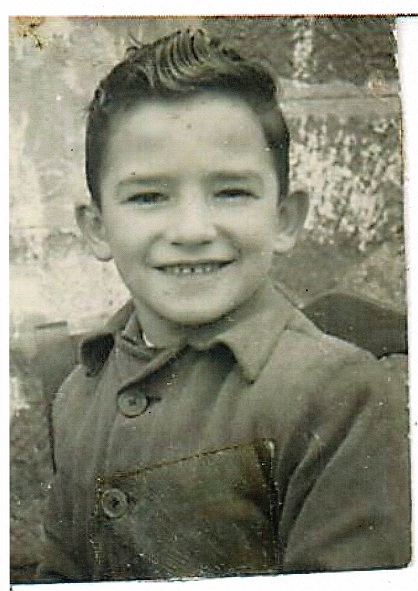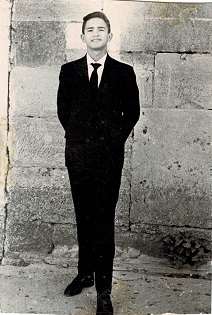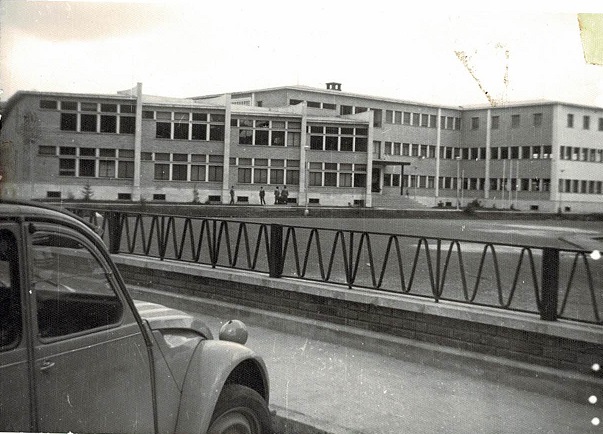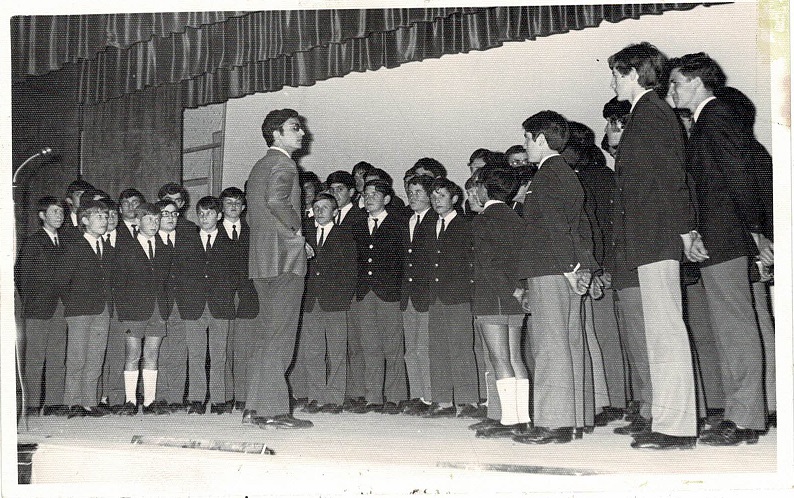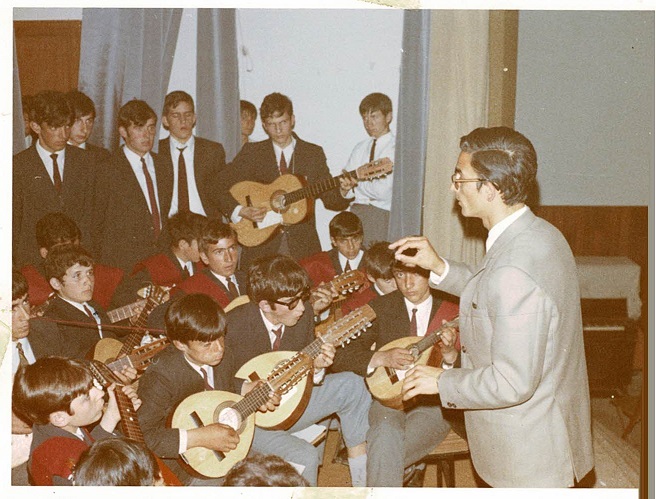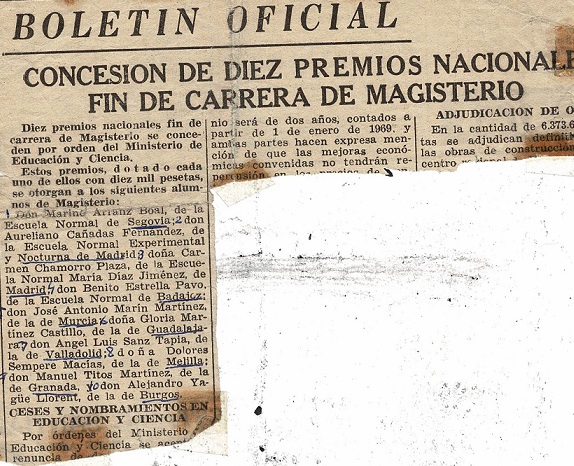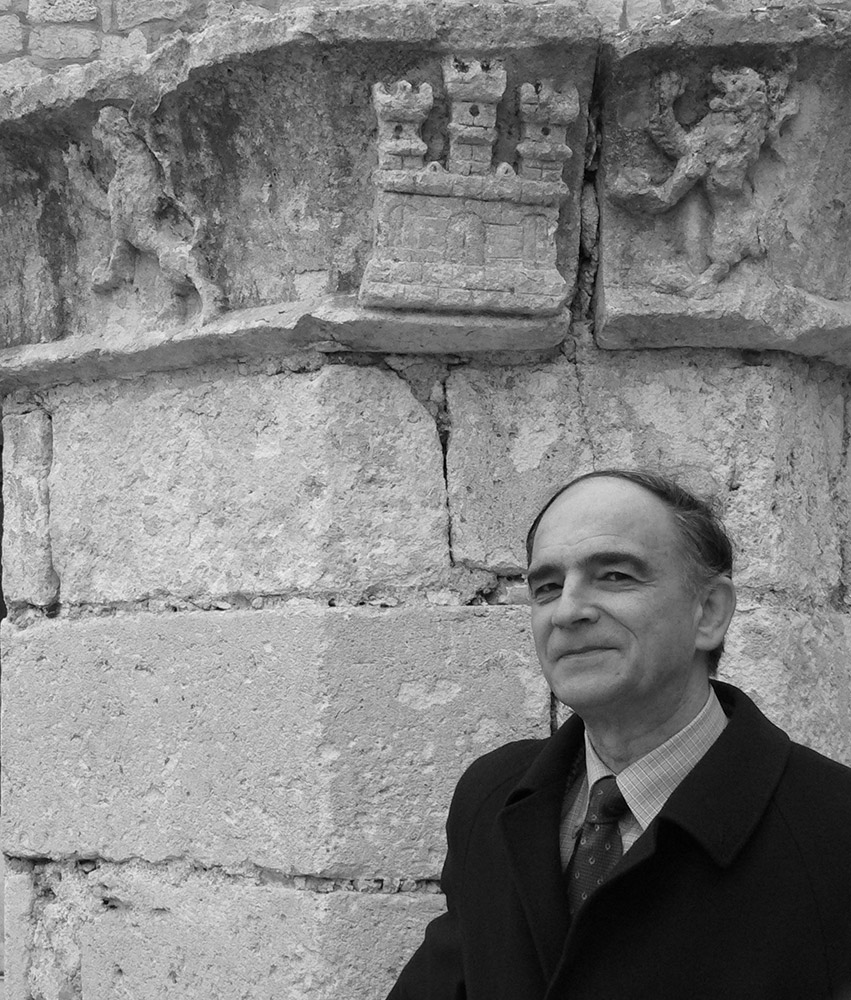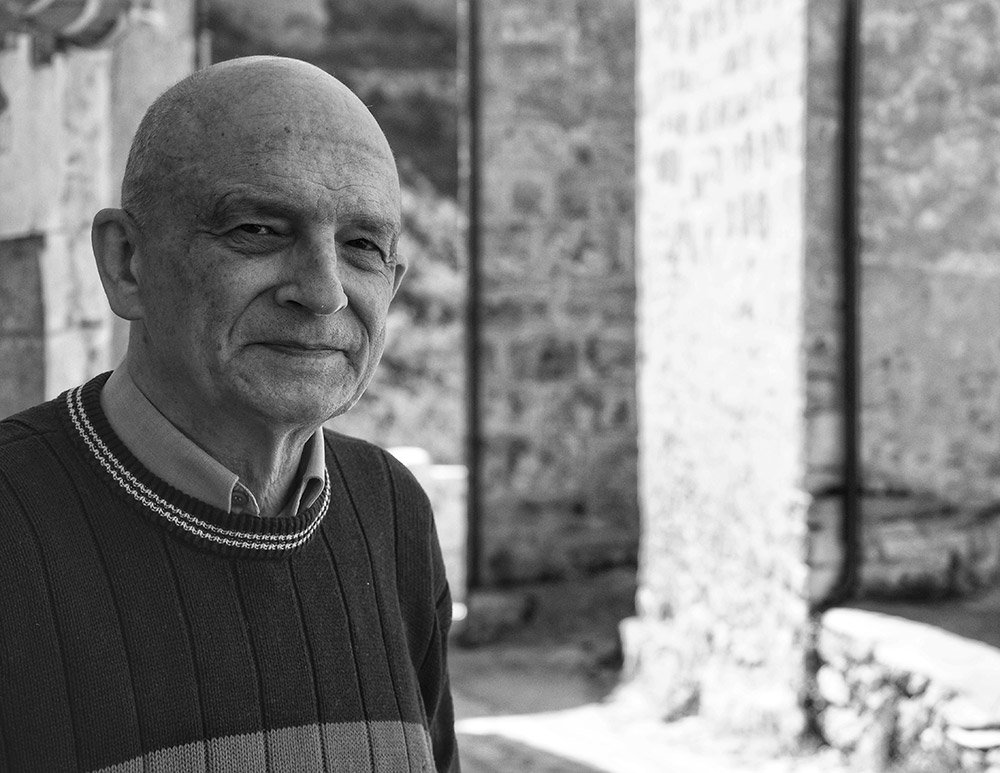
Bio
Anecdotes, experiences, ...
Birth
(Photo- Palacios de la Sierra- 1947)
Alejandro Yagüe's father, Palmiro Yagüe de Miguel, worked in the 1940s as a forestry guard in Palacios de la Sierra, the place where Alejandro was born on 27 February 1947 and where he lived until he was four years old. The first birds he heard singing were palatial, influencing in some way his way of composing. In 1951 the family moved to Santa Cruz de Juarros.
1947Early years
(Photo- Alejandro as a child)
In Santa Cruz de Juarros Alejandro spent entire days drawing on a blackboard. On a visit by the schoolmaster to the family home, he saw the Burgos Cathedral painted on the slate. He congratulated his father, thinking he was the author, and was surprised to learn that it was seven-year-old Alexander himself who had drawn it. The teacher instructed his father to take him to study at a drawing academy as soon as possible, stating that he would become a great painter from Burgos.
At school in Santa Cruz they had never been told about music. Alejandro painted everything he could get his hands on. He was very struck by some sketches that he called strange drawings. Such tracings came on Christmas greeting cards. They were drawings with five parallel stripes, on top of which were small black circles the size of pinheads with a kind of tails. He liked to paint those mysterious things.
1951Trip to Valladolid
(Photo- Marianistas. Valladolid. 1958. The boy holding the ball)
Alejandro, aged 10, left Santa Cruz de Juarros by bus for the Marianist Postulancy at La Rubia in Valladolid. There he will meet other children from all regions of Spain. He will not see his parents again until next summer's holidays.
1958His start in music
(Photo- Madrid- Television Colegio Niño Jesús-Marianistas)
Alejandro would always remember the first day he entered the chapel of the boarding school in Valladolid. A Marianist named Antonio Bringas began directing the Postulancy choir. Alexander was totally impressed by the sound that reached him. He was positioned behind the seniors (tenor-basses) and the acoustic effect that reached his ears was extraordinary. In fact, he never forgot it in the composition of his polychoral works. This encouraged him to join the choir. One day, Don Donato told them that he was going to teach them music and to their surprise, the teacher began to paint on the blackboard the same strange drawings that he painted on his blackboard in Santa Cruz. It turned out that it was called... music! Music was the art of drawing strange pictures and the best drawer would end up being the best musician.
He was soon recommended to join the boarding school's rondalla. Within a few weeks, Alejandro learned to play the guitar. He stood out in the joint performance of the Marianist choir and rondalla in Madrid, on Televisión Española. It was in the 1960s when this organisation took its first steps on the Paseo de la Habana. They also gave 14 more concerts in Madrid.
From a very personal point of view, Yagüe's dream was to become a pianist and, subsequently, his efforts were focused on the piano.
1960sDiscovering his vocation
(Photo- Valladolid, Marianistas)
He then moved to the novitiate in Avila, where he worked as an organist on a small harmonium. But his vocation was not to be a friar. Therefore, on Monday, 17 August 1964, he left the Marianist novitiate and returned to Burgos. In September of the same year, his father enrolled him in the sixth year of the baccalaureate at Cardenal López de Mendoza, although Alejandro had already decided to become a musician. Little by little he got to know the cultural life of Burgos on his own.
1964Immersion in their musical studies
(Photo- Colegio Menor Generalísimo Franco de Burgos- 1966)
History of Art was studied in the sixth year, but the only art that was not studied was music.
One day Alejandro saw a young man carrying a violin in Laín Calvo Street. He followed him and realised that he was entering the Municipal Academy (the origin of today's Municipal Conservatory of Music). In April 1965, at the age of eighteen, he went to the house of the teacher Ángel Juan Quesada, director of the Academy, to explain that he wanted to study there. Alejandro had been self-taught and had no formal musical training, so Quesada discouraged him from trying. But Alejandro presented him with a composition of his own and the director immediately told him to enrol at the centre.
Alejandro studied Music at the Teacher Training College. In the meantime, he stayed at the Colegio Menor Generalísimo Franco in Burgos. When she finished her second year of teaching, she was awarded a scholarship to study music pedagogy in Madrid.
He finished his teacher training studies with distinction and with an Extraordinary Prize.
The Ministry of Education organised a national competition between Teacher Training Schools, in which Alejandro won the National Teacher Training End of Career Award (B.O.E., 10 April 1969).
In the 1968-69 school year, there were no competitive examinations for the teaching profession and he was employed as a Physical Education teacher at the Jesuit school.
At the Conservatory of Burgos he continued his piano studies, and on his own he began to study harmony.
1965Resourceful student
(Photo- Alejandro Yagüe giving a piano concert)
During the summer of 1966 Alejandro worked in the Sargentes de la Lora oil field and during the following summer in the Huidobro copper mines. During his holidays, Alejandro had to travel to Sedano, where he could not perform any piano exercises. The only option was to play the church harmonium. Alejandro came up with the idea of building an ingenious keyboard out of cardboard and wooden keys to exercise his memory.
1966Musical studies at the Conservatory of Burgos
(Photo Identity Card of the Conservatorio Elemental de Música -Antonio de Cabezón)
The school year began and Yagüe had to combine his teaching studies with his studies at the Conservatory. In one academic year he finished all his solfège studies and three piano courses.
On alternate days, in the afternoons when he finished his time at the Teacher Training College, he would run straight to the Orfeón Burgalés, where there was a piano where he could practice for half an hour. Music scores were very expensive, and his concern for money led him to participate in various poetry and painting competitions, among others, in which he won several prizes.
During the 1966-67 academic year, the Ministry of Education granted official validity to the musical studies at the Conservatorio de Música de Burgos.
In three years he completed all the musical studies that could be taken at the Conservatorio de Burgos. He had to take the rest of the subjects unofficially, with private classes with the teacher Quesada, and take exams on his own at the Valladolid Conservatory.
From the beginning, it was clear to Yagüe that he wanted to be a composer, so it was very important to focus on harmony and piano studies.
In October 1970, after passing the competitive examination for the teaching profession, he was assigned to the Alejandro Rodríguez de Valcárcel school, as he obtained the best marks in Burgos. His first teacher's salary was spent entirely on buying sheet music.
The need to learn a good compositional technique led him to the conclusion that if he wanted to continue his studies he would have to go to Madrid.
1966His life at the Junior College
(Photo- Choir of the Colegio Menor directed by Alejandro Yagüe during the 1970-71 school year).
For one year (1968-69) Yagüe was Educator of the Colegio Menor. But what really interested him was to continue his musical studies with maestro Quesada, and he needed to buy a piano. He therefore proposed to the headmaster of the Junior College to advance him his annual salary and thus acquire a second-hand piano. In return he founded and conducted the choir at the Colegio Menor in 1969. The headmaster agreed, and from then on he had his piano in the assembly hall where he could study late into the night without disturbing anyone.
At the Colegio Menor, the choir rehearsals started, they were always looking for pieces to sing, in Burgos there were no choral scores. If Alejandro ordered them from Madrid they were expensive. That is why he had to use a pseudonym so that no one would suspect that he was the author of the works they began to sing. He came up with the name "Diaghelis", that's how it all started.
The soprano and alto voices were sung by the students of the first and second year of baccalaureate. The rest were done by students in higher education or teacher training courses. They participated in three national junior college choir competitions.
In the Badajoz competition they win an accésit (1969). In Zaragoza (1970) the compulsory work was not to Yagüe's taste and he decided to harmonise it in his own way, bypassing the rules of the competition. The president of the jury told him that although they had brought a more interesting work than the compulsory one, they were disqualified. His choristers were angry and booed him when he came out to the theatre.
In the choir, very curious anecdotes took place on a daily basis. Every day, after dinner, Alejandro rehearsed for an hour in the assembly hall.
1968 - 1969Rondalla and Choir
(Photo- Choir of the Colegio Menor directed by Alejandro Yagüe during the 1970-71 school year).
Faced with the need to cover expenses, it occurred to him to make a new proposal to the director of the Junior College. As well as leading the choir, it would also lead the rondalla. The director agreed. Therefore, while Yagüe was preparing for the competitive examinations, he also ran the rondalla and the choir of the Colegio Menor.
1970Winning their first prizes
(Photo. Official Bulletin- National End of Degree Awards-)
The Ministry of Education presented the rules for the awarding of ten National End-of-Degree prizes. Those for teachers were endowed with 10,000 pesetas. Yagüe was eligible to apply because he had been awarded the Extraordinary Prize at the end of his teaching degree in June 1968.
The National Prize consisted of a written exam of about two hours on a subject imposed by the Ministry of Education in Madrid in which he had to demonstrate a good capacity for synthesis of all his knowledge related to pedagogy in general, didactics and methodology. It was an opportunity to solve their precarious economic situation.
When Dolores Abelenda, the director of the Teacher Training College in Burgos, told him that he had won the National End of Degree Award, he thought that, at least for a while, he would not have any financial problems.
1968Teacher Training Examinations
(Photo. Clipping from Diario de Burgos - Tribunal de Oposiciones a Ingreso en el Magisterio Nacional-.
)
Having obtained the number one position in the competitive examinations in Burgos, his first provisional post (1970-71) was as a teacher at the Alejandro Rodríguez de Valcárcel School, in Gamonal, in Burgos itself. The scores for each exercise were published in the Diario de Burgos.
In that first assignment, Yagüe was in charge of a group of forty-two six-year-old pupils. Their job was to teach them to read, write and perform the most elementary mathematical operations.
That same 1970-71 academic year, in which he worked as a teacher in Burgos, he combined his teaching work with his eighth-year piano studies, the last year of his piano degree. He continued to board at the Colegio Menor, where he had his piano in the assembly hall.
1970 - 1971
Photo. Portrait Alejandro Yagüe
1971
The hard road to excellence
Having finished his piano studies as a free student in Valladolid in June 1971, Yagüe decided to continue his studies, which were called “virtuosity”, at the Conservatorio Superior de Madrid. In September he travelled to Madrid to register. He was told that the entrance examination was at the beginning of October and that he had to present Bartok’s Opus 14 Suite as a compulsory work. He had to hurry up and memorise this piano piece as quickly as possible, at the same time as reviewing the repertoire he had studied in the eighth year of piano.
At the beginning of September, he was to take up his post as a permanent national teacher in the Burgos village of Santibañez Zarzaguda. But Alejandro needed that time to prepare for his entrance to the Conservatorio Superior de Madrid. Thus, on the same day he took up his post as a teacher and requested his leave of absence. He never worked as a teacher again, as he decided to pursue higher studies in music.
Coincidentally, the day he was admitted to the Conservatorio Superior de Madrid, his father died.
During that academic year he travelled once a week from Burgos to Madrid by bus to attend the piano classes given at the Conservatory by the pianist Pedro Lerma. At the same time, Alejandro was taking his fourth year of harmony classes in Burgos with Ángel Juan Quesada. He was also in charge of the musical activities at the Colegio Menor, where he continued to be a guest and had his piano in the assembly hall.
Alejandro decided to move to Madrid to study composition, conducting and piano. His idea was to pay for his musical studies by founding and conducting choirs in some Colegio Mayor, as he did in Burgos. An important educational centre in Madrid showed interest in his proposal. In October 1972 he moved to the capital.
In addition, at the Royal Conservatory of Music in Madrid he enrolled in piano (9th course of virtuosity), in the preparatory course for conducting, in the first course of counterpoint and in the first course of composition. During these years he founded a men’s choir at the Academia José Antonio. Yagüe used the piano in the auditorium of the Academy.
In 1976 Alejandro was informed that he had been awarded a scholarship to study in Italy. He then told the head teacher that he was taking the final management exam, as he was leaving for Rome the following year. That meant finishing a year ahead of his classmates. Alexander had to learn part of the numbers from Stravinsky’s “Soldier’s Tale” and conduct part of Chopin’s concerto number two for piano and orchestra. He thus completed his conducting studies with conductors from the first class.
Alejandro was awarded at the same time the Juan March scholarship and the scholarship to be a two-year boarder at the Spanish Academy of Fine Arts in Rome. He had to renounce his grant from the Juan March Foundation.
Stage in Rome
(Photo. Identity Card of the Pensionado Academia Española de Bellas Artes de Roma)
On Saint Cecilia's Day 1976, Alejandro arrived at the Spanish Academy of Fine Arts in Rome. He visited the prestigious composer Goffredo Petrassi. Prior to the interview, Yagüe and Petrassi had already been in contact through letters and writings.
Some of his works (performed as a student) will be premiered at the Academia Santa Cecilia. However, in order to pay for his studies, he decides to take a job as a pianist at a ballet school in Rome.
In the summers of 77 and 78, coinciding with his stay in Italy, he attended the Accademia Chigiana. Alejandro is taught by composer and conductor Franco Donatoni. In his second year he received a scholarship from the academy.
19761978
His German journey
In September 1978, Yagüe moved to Munich, as he received an exchange grant from the Ministry of Foreign Affairs. He will stay at the Spanisches Kolleg.
There he entered the electroacoustic music studio of the Musikhochschule (Cologne Conservatory of Music). That same year he won the Córdoba composition competition (Premio Arte).
In 1979 he was awarded the Humboldt Scholarship. For a few months he goes to Rotenburg of the Tauberg for a German language course. On 10 December 1980, in Madrid, in the theatre of the Círculo de Bellas Artes, the 1st Prize for Composition for Orchestra of Laudes, organised by the Sociedad Artística Riojana under the patronage of the Directorate General of Music, was awarded. The jury awarded the score entitled “Bardulia” composed by Alejandro Yagüe as the winner.
While he continued his stay in Germany, he obtained a new success in a national competition for his polyphonic work “Cantus Firmus nº 3” based on three popular motifs from Burgos collected in the Cancionero de Olmeda. It was the 1st Competition for Youth Polyphonic Works organised by the Spanish Ministry of Culture. Later, once he had settled in Spain, he received several prizes in competitions held in Barcelona (1983) and Zamora (1984).
During his stay in Germany from 78 to 82, he produced a voluminous work of electronic music, which at that time was unknown in Spain because there was no studio or hall for listening to it. The work is entitled “Todo lo Cría la Tierra” and refers to a harvest song found on page 48 of the Cancionero del P. Olmeda. The fact that a work of contemporary music, specifically electronic music, takes a popular text as its premise is something exceptional. In the Cologne studio he made it possible to transform and modulate the human voice, achieving sounds that are unknown and that in practice no choir can achieve.
1982
Back to Spain
On 27 April 1982, Yagüe returned to Spain. In October, a post as a solfège teacher at the Professional Conservatory of Burgos was advertised and he was successful. He starts teaching Solfeggio (beginners), piano (beginners) and musical forms. It was his first work dedicated to music.
Soon problems with the director of the Conservatoire began to appear.
In its desire for democratic teaching, it decides to appoint a person from among the students to act as a delegate. On the first day a vote was held in which a student was elected as class delegate. A few days later, this vote had to be annulled, due to pressure from the management.
Alejandro starts to perform monthly concerts of the students. He also sent students to the local radio station to talk about musical topics, in order to publicise the Conservatoire’s activities. In addition, the pupils began to attend the concerts of the Philharmonic Society. Another of the activities included are musical auditions for the elderly. In 1987, he began a study of musical institutions in Burgos together with the students of the Conservatory. The works were published in Diario de Burgos on Sundays during 1988.
1987
Problems with the conservatory
In 1987 Yagüe sat the competitive examinations for Harmony at the Municipal Conservatory of Burgos. Despite all the obstacles, he managed to pass the competition.
Alejandro starts the new school year in October. He is looking forward to teaching harmony at the Conservatorio de Burgos. The director of the conservatoire tells him that he will only teach this subject to the first year.
Yagüe does not accept the situation, as he has passed the competition. It goes to Madrid. Speak to the Chief Inspector of Spanish Conservatories and ask him if the School Council is compulsory in the Conservatory of Burgos. He tells her that it is compulsory, but that if she reports it she will be in a lot of trouble. Even so, he decides to denounce in writing the lack of the compulsory School Council at the Professional Conservatory of Burgos. But time goes by and the Ministry of Education does not make a statement.
The Humboldt Foundation invites you to attend a reunion of former scholarship holders in Germany. He agrees with the students in Burgos on how to make up the classes and leaves for Bonn. On 21 January 1988 he returned to Spain. On the 23rd, he received an urgent letter stating that his absence from work was a very serious misconduct leading to the termination of his contract.
After some time, the second court in Burgos ruled that the real reason for the dismissal had its origin in the letters sent by Professor Yagüe to the provincial directorate of the MEC and to the General Inspectorate of Conservatories, in which he denounced irregularities at the centre. As a result, they were forced to reinstate him, but Yagüe had been preparing for the competitive examinations for the Conservatorio Superior de Salamanca, where he took up his post on 1 October 1988, and where he would work as Professor of Composition until his retirement.
Even so, it maintains a very good relationship with the Choir of the University of Burgos, with the Ciudad de Burgos Music Band and other choirs in the city such as the San Esteban Choir, the Orfeón Burgalés and many others in the capital and the province. The Coro Interludio, which was founded in the autumn of 1998, recorded a CD with the eight notebooks that make up Alejandro’s “Spanish Folk Songs“, with which they also won important national prizes. It also has a special relationship with the Schola Cantorum. In 2005 he was made an Honorary Member.
Last years of his career
In the city of Burgos he is recognised as a Báculo de Oro (Golden Staff). Alejandro also received the “City of Burgos Creativity Award” from the City Council in collaboration with the Strategic Plan. He also receives the recognition of Good Neighbour of the City of Burgos.
The Asociación Cultural Las Calzas joins the recognition in 2013, highlighting Alejandro’s musical work and his projection abroad and being a reference in the specialities of composition, orchestra conducting and piano.
He has also been a member of the jury for the last three decades at the Certamen de la Canción Marinera in San Vicente de la Barquera. In the 41st Contest (year 2008) the work entitled “Dos Olas” by Alejandro Yagüe is the compulsory work. He also acts as a member of the jury in high-profile competitions, including the Certamen Coral de Ejea de los Caballeros (Ejea de los Caballeros Choral Competition). The compulsory entry in the 39th competition in 2009, “Dibujo en el Agua” is written and composed by Alejandro.
She enters an international composition competition with the work for mixed choir Pater Pauperum and is selected as a finalist in the XII International Choral Composition Competition Seghizzi of Gorizia (Italy). In October 2015, he won first prize in Switzerland at the Europa-Cantat International Composition Competition for polychoral works with instrumental and organ accompaniment for his work “Migratio” for double choir with trombone quartet. In July 2016, the artist from Burgos won third prize in the International Diabelli Contest with the piece “Nec Sol Lucebat“, performed in Germany by the choir Chismos Chor.
Eternal legacy
On 6 June 2013, during a routine medical consultation, he was diagnosed with cancer. Despite this, he continues to compose and to show his great human qualities.
The Burgos composer Alejandro Yagüe passed away on 24 August 2017 at the age of 70, leaving behind an immense musical legacy. Nevertheless, no one dies as long as his music, his art and his person remain alive.








